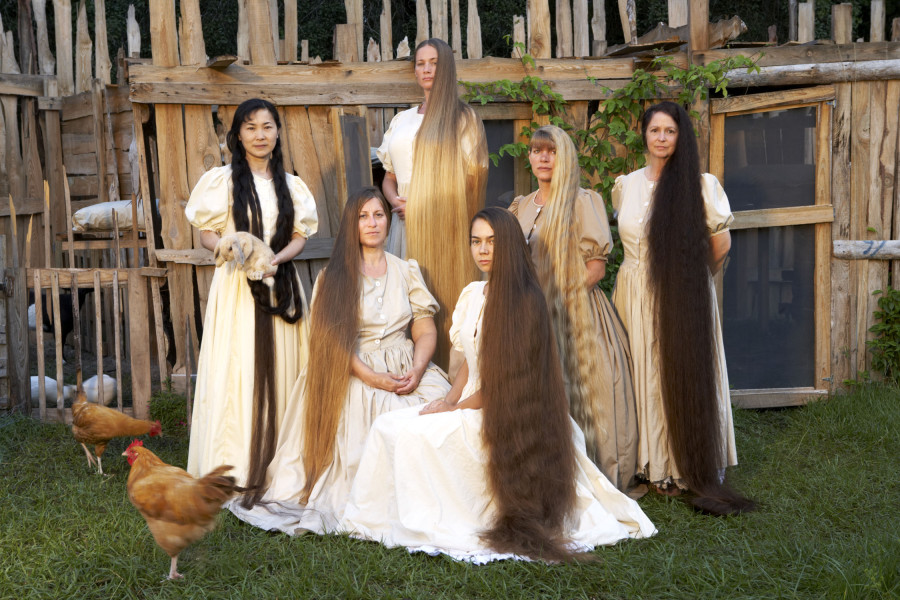The 30 Best Art Books of 2013
December 12, 2013
The work delves into the accomplishments of 24 international women artists born in the years following 1960 and serves as a follow-up to Eleanor Heartney, Helaine Posner, Nancy Princenthal and Sue Scott's 2008 book, "After the Revolution: Women Who Transformed Contemporary Art." With themes like "Bad Girls" and "Domestic Disturbances," the publication appeals to radical feminists, art history buffs and anyone who cringed at Ken Johnson's remarks about female artists this year.
10 Women Artists of the New Millennium You Should Know
By Katherine Brooks
November 4, 2013
Shirin Neshat (Photo by Selin Alemdar/Getty Images)
In 2008, four female authors gathered together to address a decades-old question, once posited by art historian Linda Nochlin: "Why have there been no great women artists?"
The authors sought not to reaffirm the implied statement -- that, historically, men have dominated the world of art. Instead Eleanor Heartney, Helaine Posner, Nancy Princenthal and Sue Scott opted to methodically explore the new reality of the art realm after the feminist movement, exploring the growth and success of women in the field, and ultimately tossing Nochlin's question out the window entirely.
The result was After the Revolution: Women Who Transformed Contemporary Art, a publication dedicated to the careers of 12 influential women artists working in the late 20th century, ranging from Louise Bourgeois to Shirin Neshat to Marina Abramovic. Through analysis of their works' critical success, market value and institutional support, Heartney and company reveal the progress women artists have made since the 1970s, adding to a foundation of scholarship that stands to push Nochlin's question into extinction.
"The battles may not all have been won," the authors wrote. "But barricades are gradually coming down, and work proceeds on all fronts in glorious profusion."
While After the Revolution paid homage to an earlier generation of women in art, the book only touched on the channels necessary to project the progress of predecessors onto the hordes of emerging women artists entering the field at the time. So, nearly five years after the publication of their first tome, they're analyzing how the radical works of Cindy Sherman and Kiki Smith have laid a foundation for a new age of women artists in The Reckoning: Women Artists of the New Millennium.
The work delves into the accomplishments of 24 international women artists born in the years following 1960. Organized according to four themes -- "Bad Girls" who explore unconventional notions of gender and race, artists who focus on "History Lessons" that take into account the role of the self and globalization, "Spellbound" artists whose work leans toward the irrational and surreal, and women who take on issues related to the home and family in "Domestic Disturbances" -- the work stands to show that women have not only invaded the canonical space once reserved primarily for men, but they've also actively propelled the world forward, using media like video and performance to expand our concept of art.
Heartney et al recognize that there is still room for growth, particularly in terms of women's gallery representation and the number of solo shows headlined by female artists in museums. However, the four authors focus less on the numbers and more on the nature of the art being made by women, agreeing with critic Holland Cotter's famous words, "Feminist Art... is the formative art of the last four decades."
In honor of the book's release last month, here's a preview of the women profiled in The Reckoning.
Wangechi Mutu, This you call civilization?, 2008. Courtesy of the artist and Susanne Vielmetter Los Angeles Projects
Exhibition view of The Parade: Nathalie Djurberg with Music by Hans Berg, New Museum, New York, 2012. Courtesy of Zach Feuer Gallery, New York, and Giò Marconi Milan. Photo by Benoit Pailley.
Mika Rottenberg
Mika Rottenberg, Still from Cheese, 2007. Courtesy of Andrea Rosen Gallery, New York, and Nicole Klagsburn Gallery, New York.
Katarzyna Kozyra
Katarzyna Kozyra, Cheerleader, 2006. Production photograph by Marcin Oliva Soto.
Sharon Hayes
Sharon Hayes, In the Near Future, 2009. Courtesy of the artist and Tanya Leighton Gallery, Berlin.
Yael Bartana
Yael Bartana, Trembling Time, 2001. Courtesy of Annet Gelink Gallery, Amsterdam, and Sommer Contemporary Art, Tel Aviv.
Cao Fei
Cao Fei, RMB City 4, 2007. Courtesy of the artist, Lombard Freid Gallery, New York, and Vitamin Creative Space, Guangzhou.
Kate Gilmore
Kate Gilmore, Standing Here, 2010. Courtesy of the artist.
Klara Liden
Klara Liden, S.A.D., 2012. Photo by Farzad Owrang, courtesy of Reena Spaulings Fine Art, New York.
Tania Bruguera
Tania Bruguera, The Burden of Guilt, 1997–99. Image courtesy of Museo de Bellas Artes, Caracas.










